2. 青岛海洋科学与技术试点国家实验室;
山东. 青岛 266237;
3. 中国水产科学研究院渔业机械仪器研究所 上海 200090
2. Pilot National Laboratory for Marine Science and Technology (Qingdao), Qingdao, Shangdong 266237, China;
山东. Fishery Machinery and Instrument Research Institute, Chinese Academy of Fishery Sciences, Shanghai 200092, China
我国海水养殖主要包括陆基工厂化养殖、池塘养殖、网箱养殖和围网养殖,主要集中在0~10 m浅海的海湾、滩涂和近岸水域(王东石等, 2015)。2020年,我国海水养殖总产量达2 135.31万t,同比增长3.39%,取得了前所未有的成就(农业农村部渔业渔政管理局等, 2021; Zhao et al, 2021)。但发展过程中也出现了许多问题,养殖方式总体上还比较粗放,生态容纳量超载、病害频发和环境恶化等问题日益突出(谭鲁玉等, 2018; 姜燕等, 2020)。海水养殖的转型发展方向在于拓展海洋新空间,利用深远海优质海水资源进行水产健康养殖(徐皓等, 2020)。2019年初,由农业农村部等十部委联合印发的《关于加快推进水产养殖业绿色发展的若干意见》,明确要加快引导近海养殖向深远海发展,大力发展深远海养殖。深远海大型围栏养殖因养殖空间上至海面、下至海底,甚至包括自然岸线,环境自然、空间大、水体交换流畅,备受业内和水产行业主管部门重视,成为海洋设施养殖转型创新发展的热点模式,近年来发展迅速(石建高, 2019; 邹国华等, 2021)。本文主要概述我国深远海大型围栏养殖发展现状及其研究进展,并结合认识深远海大型围栏养殖发展中存在的问题,提出相应对策建议,旨在为我国深远海大型围栏养殖的健康有序发展提供参考。
1 围网养殖发展概况围网养殖是指在淡水湖泊、水库、河流水域或在沿海滩涂、海洋通过围、拦、隔等工程措施,圈围一定面积的水面,养殖鱼类、甲壳类等水产经济动物的一种重要水产养殖方式(贾敬敦等, 2014; 葛彩霞等, 2016)。日本是较早开展围网养殖的国家之一,早在20世纪20年代在沿岸海域就兴建了多个围网养殖场,主要开展河豚鱼(Tetraodontidae)、鲷科(Sparidae)鱼类、金枪鱼(Thunnini)的养殖(叶卫富, 2012)。挪威曾于20世纪80年代开展了三文鱼(Oncorhynchus)围网养殖实验,但养殖海域局限在较浅海域(叶卫富, 2012)。20世纪50年代,围网养殖引入中国,开始为湖泊围网养殖,后逐步在沿海滩涂、浅海及深远海水域应用(贾敬敦等, 2014; 宋炜等, 2019)。
我国海水围网养殖经历了近岸滩涂围海(包括滩涂围网和围塘)养殖、浅海围网养殖、深远海大型围栏养殖的历程(周锡瑞, 2010; 李怡等, 2017; 周文博等, 2018; 邹国华等, 2021)。由于受到海水潮汐、风浪、水深、底质、污损生物附着和海洋气象灾害等诸多因素的限制,其技术难度远大于淡水围网养殖(王磊等, 2017)。海水围网养殖设施主要有插杆式、浮绳式和桩柱式3种形式。浮绳式围网主要由网衣、绳索、浮子、锚链等组成(李怡等, 2017)。插杆式和桩柱式主要由固定于海底的桩柱以及具有鱼类拦截和海水流动的网体组装而成。目前,可用于插杆式和桩柱式围网养殖设施桩柱包括竹木桩柱、钢筋混凝土预制桩柱、钢管或塑钢桩柱等;网体包括聚合物纤维网体材料和金属合金网材料2大类(聂政伟等, 2016; 王新鸣等, 2017; 刘卫滨等, 2019)。前期发展由于缺乏必要的科技支撑,海水围网养殖一般仅局限于水深4 m以内的海域,进一步向外海拓展的后劲不足。但随着海洋开发的深化,大力发展深远海是海洋养殖产业的必然趋势,围网养殖也逐步向水质优良却充满风险的深远海推进,以增强海水养殖的质量效益,提升可持续发展水平。近10年来,随着水产养殖业及海工技术的发展,在中央和地方政府政策扶持和项目支撑下,围网养殖呈现向深远海发展的趋势,对比传统的高密度近岸网箱、滩涂围网和浅海围网养殖,深远海大型围栏养殖优势明显,围栏设施抗风浪能力明显增强;围栏有效养殖水体更大,单位成本造价低;养殖对象活动空间大,品质明显提升(表 1)。
|
|
表 1 我国不同海水养殖模式比较 Tab.1 The comparison of different mariculture models in China |
海洋资源如何被深度和广度地充分利用,以提高生产力,是世界海洋国家的共同目标。20世纪80年代,以美国、挪威、日本为代表的部分发达国家开始尝试深远海养殖方面技术探索和应用,历经30多年的发展,取得了极大的成功,引领海洋养殖设施发展的潮流(麦康森等, 2016; 桂建芳等, 2018; 徐皓等, 2021)。我国是水产养殖大国,海水养殖主要集中在沿海近岸,养殖设施以传统网箱为主,当前,我国近海养殖容量趋于饱和,总体养殖方式上还比较粗放,产业结构不合理,受外部水域环境恶化与内部水质劣化的影响,养殖空间受到挤压,养殖密度过大、病害频发和环境恶化等问题日益突出(徐琰斐等, 2021)。推动海水养殖从近海沿岸向深远海扩展,是优化海水养殖空间布局、促进海水养殖业转型升级的必然选择,且潜力巨大;对保障食物安全、改善国民膳食结构,实施健康中国战略具有重大意义(麦康森等, 2016; 徐皓等, 2020)。早在20世纪80年代中后期,我国就提出了发展深远海养殖装备的设想,但真正付出实践只是近4~5年的时间。其中,具有标志性的重大事件是2017年6月由中船重工集团公司建造的世界首座半潜式大型智能渔业养殖平台“海洋渔场1号(Ocean Farm 1)”成功交付挪威萨尔玛集团使用,令全球高度关注(徐琰斐等, 2019; 石建高等, 2021)。
目前,因世界各国海域环境、技术条件和养殖方式不同,至今尚无涉及深远海养殖定义的国际标准、国家标准。根据我国沿海海域水文特点和海水养殖基本情况,深远海养殖一般应具备以下几个特点:1. 离大陆岸线3海里以外,处于开放或半开放海域;2. 低潮位水深不小于20 m,具有大洋性浪、流特征;3. 具备规模化的养殖设施,但不限于重力式网箱、工程化围栏和养殖工船等;4. 具有机械化作业、智能化操控和信息化管理等功能。深远海海域是内温性较强的水域生态系统,而且水交换率高、污染物含量少,通过安全的养殖设施、智能化的配套装备和先进的养殖技术,可高效生产出健康、优质洁净的海产品,满足人们日益增长的对优质水产品的需求(麦康森等, 2016; 徐皓等, 2020)。
3 我国深远海大型围栏养殖现状我国深远海大型围栏养殖的研究及应用始于本世纪初,海洋工程技术、网衣新材料及其防污技术、桩网连接技术及工艺等研发与应用,使围栏养殖设施的大型化、离岸化和智能化成为可能。根据开放海域和远海岛礁特点可分为离岸式围栏和连岸式围栏。离岸式围栏,一般建造于开放海域或半开放海域(图 1、图 2);而连岸式围栏,一般是依托远海岛礁,进行一面或多面围栏(图 3)。养殖水体可达数万至数十万立方,宽阔的空间和良好的海洋水质环境,可为鱼类原生态牧养模式搭建优良条件(李明云等, 2019; 桂福坤等, 2020)。工程造价虽然一次性投入较高,但由于维护管理相对方便,且桩柱可作为休闲旅游的附加平台,提升潜在价值,因此,近年来备受海水养殖企业的青睐,呈现快速发展的势头。
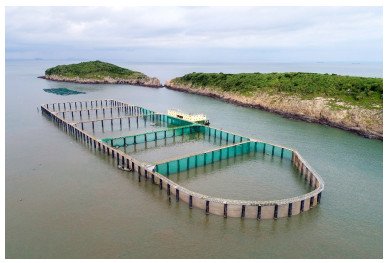
|
图 1 建造于半开放海域的离岸式围栏 Fig.1 The offshore fence built in semi open sea area |
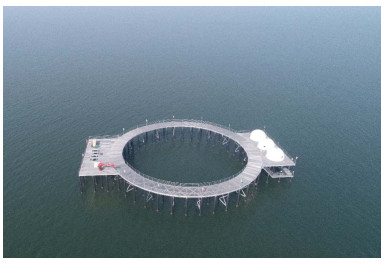
|
图 2 建造于开放海域的离岸式围栏 Fig.2 The offshore fence built in exposed sea area |
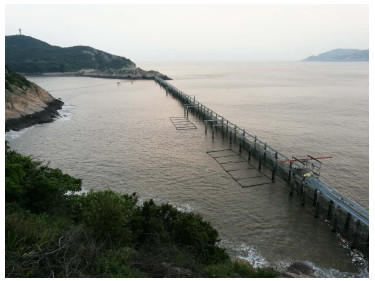
|
图 3 连岸式围栏 Fig.3 The shore fence |
2012年,中国水产科学研究院东海水产研究所与浙江台州椒江星浪海水养殖合作社在浙江台州大陈岛海域建造了我国首个大型围栏养殖设施(图 4)。该设施为周长约为360 m的正八边形布局,养殖水体约5万m3。固定桩采用钢筋混凝土桩,直径为80 cm,间距为5 m,共计70根桩。网衣由上部超高强聚乙烯网衣与下部铜合金编织网组成。后因台风受损后进行了修复,局部增加双排桩结构,增加至100余根,后续增加的桩改为钢管桩。该设施可养殖大黄鱼(Pseudosciaena crcea)约60万尾。
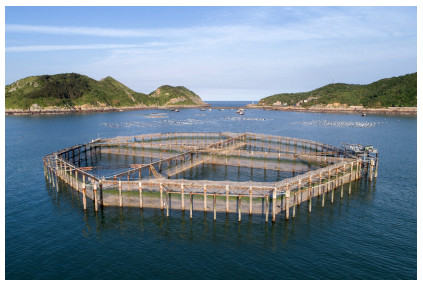
|
图 4 国内首个大型围栏养殖设施 Fig.4 The first large-scale fence aquaculture facility in China |
2015年,中国水产科学研究院东海水产研究所联合浙江温州丰和海洋开发有限公司设计研发了双周圆大跨距大型围栏设施(图 5)。该围栏外圈周长为498 m,内圈周长为438 m,最大养殖水体约为30万m3;内外圈之间的跨距高达10 m,均有水泥管桩与UHMPE网衣组成。该围栏具有工作和观光平台,还配备了起捕、投喂等装备(周文博等, 2018)。主要用于仿生态养殖大黄鱼、黑鲷(Sparus macrocephalus)、石斑鱼(Epinephelus spp.)和斑石鲷(Oplegnathus punctatus)等经济鱼类。
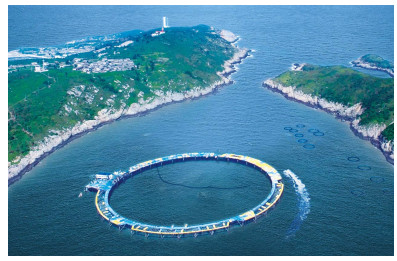
|
图 5 双周圆大跨距大型围栏养殖设施 Fig.5 Double-circle long-span large-scale fence aquaculture facility |
2016年,浙江海洋大学采用“悬链式大型围栏工程技术”在舟山桃花岛南部建设了10万m3水体的连岸式大型围栏养殖设施,解决了大黄鱼自然环境下的越冬、投喂、起捕等关键问题,养殖品质得到市场高度认可,曾创下了7条鱼售价4000元的良好记录(图 3)。该围栏设施是舟山市第一个大型高端生态围栏养殖工程技术产业化应用示范基地,成为海洋生态养殖模式创新的示范样板,推动舟山地方海洋养殖产业转型升级与创新发展(桂福坤等, 2019)。
2017年,中国水产科学研究院黄海水产研究所与山东莱州明波水产有限公司合作在莱州湾远海开放海域建成钢制管桩生态围栏养殖设施,养殖水体达到16万m3;配套研发了鱼苗转运投放、饲料投喂、成鱼收获、物联网监控等附属装备,基本实现了大型围栏养殖的自动化与智能化操控管理;还开展了斑石鲷、半滑舌鳎(Cynoglossus semilaevis)和梭鱼(Sphyraena)等鱼类混合养殖实验,取得了良好的效果(图 6)。
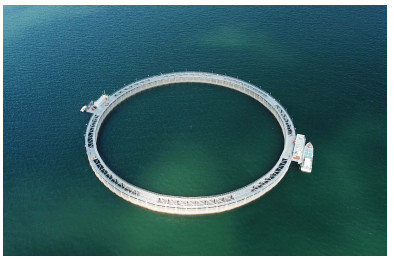
|
图 6 钢制管桩式生态围栏养殖设施 Fig.6 Steel pipe pile type ecological fence aquaculture facility |
深远海大型围栏养殖是集成海洋工程、新材料应用和生态养殖等于一体的新兴的生态养殖模式,主要由“大型围栏工程+配套养殖设施+养殖技术工艺”三部分构成。目前,除上述代表性深远海大型围栏养殖模式外,还有多个深远海大型围栏养殖设施已在浙江台州、温州、舟山,山东莱州和广东湛江等地实施或规划(陈恒等, 2015; 周文博等, 2018; 李磊等, 2019)。围栏的形状有圆形、多边形,也有的是长方形,如果依托外侧岛礁进行围栏设置,可以采用任何形状。主要开展大黄鱼、斑石鲷、黄条
科学选址是深远海大型围栏建设的重要环节之一。围栏选址应与海洋功能区划相协调,考虑与港口、航道、锚地、旅游风景区等的相互影响,并要充分考虑海区的动力环境条件,全面评估养殖海域的风浪和水流条件,还要求综合考虑养殖对象的行为特性和投资可行性,在养殖对象的耐受能力和投资额度范围内,选择适宜的养殖海域(石建高, 2019)。围栏养殖对底质条件没有太多的要求,砂质海底、淤泥质海底、岩礁海底均可以用于建造围栏工程。围栏建造前,需要对海区进行必要的地质勘测,根据地质勘测资料设计满足抗风浪结构安全要求的围栏工程。
4.2 深远海大型围栏的建造深远海大型围栏一般由桩柱系统和网衣系统等结构组成,网衣系缚于桩柱上,并与海底嵌合。
桩柱系统的安全是确保围栏工程安全的核心所在。目前,围栏设施的柱桩主要采用钢筋混凝土桩和钢管桩,涉及到连岸式围栏工程的,可采用嵌岩灌注桩。钢筋混凝土桩和钢管桩桩径一般为60~100 cm,具体根据对桩柱的强度需求而定;桩长一般在20~40 m之间,部分工程达到50 m以上。桩长主要取决于所在养殖海域的水深和地质情况,一般地质淤泥为主的,桩长要求较长,砂质海底或有砂砾层的海底,桩长要求较短,具体根据桩基工程的抗倾覆、抗弯和抗剪切强度设计进行选择。桩柱的纵向间距一般为5~8 m,常用的为6 m,具体要综合考虑桩柱的直径、网衣系统的布设要求,根据网衣系统的荷载强度设计要求而定。桩柱平面布局一般采用双排桩或三排桩结构,横向间距一般为3~5 m,少数工程也有采用单排桩结构的,但仅适用于周围有较好风浪掩护条件的海域。
网衣系统常采用金属铜合金网、超高分子量纤维网、PE网、龟甲网(PET网),也有部分工程采用防腐处理后的金属铁丝网。网衣布设的原则是保证网衣连接牢固的前提下,避免网衣与柱桩的摩擦,防止网衣移动及磨损(国家海水鱼产业技术研发中心, 2018)。网衣的布设有整体布设和分片布设2种模式。整体布设是指网衣系统连成一片完整的网衣,然后系缚在桩柱上,底部设置铁链,嵌入海底泥层中,达到防逃要求。分片布设是指网衣系统设计成片状,具体根据桩柱之间的间距和高度进行设计,然后两侧系缚于桩柱上,安装时分片安装即可。分片布设的围网具有安装难度小、更换方便,灵活性要优于整体布设。
除上述围栏固定桩及其建造技术、网衣选配及连接工艺外,我国科研院所和高校对围栏工程数值模拟、桩柱结构力学特性、网衣水动力性能等也进行了相关的研究(桂福坤等, 2017; 陈天华等, 2018; 王刚等, 2018、2019; 邹海生等, 2020)。
4.3 深远海大型围栏养殖配套装备深远海大型围栏主要包括大水面自动精准投喂、鱼群状态监测、网衣清洗、渔获分级高效起捕、养殖环境与安全监控等机械化与智能化配套装备。大型围栏由于地处深远海,浪高流急,海况恶劣,更易遭受台风等灾害的侵袭,相关的机械化作业装备、智能化管理系统以及物联网信息化系统的研发还处在起步阶段,尚未形成系统性、系列化产品(张业韡等, 2019)。
4.4 深远海大型围栏养殖技术与工艺深远海大型围栏养殖技术与工艺主要包括适宜规格苗种培育、苗种转运与投放、饲料选择与投喂量、疾病防控及日常监测与管理等。一般要依据不同的养殖品种制定不同的养殖模式、技术工艺及养殖参数。
目前,浙江围栏养殖鱼类品种主要是大黄鱼。大黄鱼越冬的极限水温为7℃,围栏养殖大黄鱼难以越冬,一般在每年的4~6月投苗,12月或次年的1月起捕,苗种规格250~300 g/尾,商品鱼平均规格在500 g/尾左右。由于生活环境更接近天然,还有一定的天然饵料作为补充,围栏养殖大黄鱼个体大、体形修长、体色金黄,风味鲜美,而且养殖大黄鱼用药少,深受高端水产品消费市场喜爱。大规格的商品鱼市场售价高达200~400元/kg,是普通养殖大黄鱼的5~10倍。
山东围栏养殖所处海域低温期比较长,一般选择大规格苗种,以提高养殖成活率,缩短养殖周期。围栏养殖斑石鲷规格在400 g/尾以上,半滑舌鳎规格在500 g/尾以上,黄条
与深水网箱养殖、筏式养殖等海洋设施养殖系统一样,大型围栏养殖逐步向水质优良却充满风险的外侧深水海域推进,也势必面临着台风、风暴潮、海流等海洋动力环境的考验,其工程设施的安全与否是决定围栏养殖成败的关键;智能化管控是保障大型围栏养殖降本增效、增强抗风险能力的有效途径;高效生态养殖技术是构建环境友好型和生态功能型的绿色深远海大型围栏养殖模式重要保障。深远海大型围栏养殖设施从首例建造,到后续逐渐发展,企业之间互相借鉴,不断加强柱桩的强度,优化了网衣的连接技术,但受限于发展历程较短,关于大型围栏的基础研究仍比较薄弱,在一些技术环节与配套装备方面还需要进一步完善。其中,最为关注的4个问题:(1)设施自身的安全问题,包括桩柱结构、网衣系统、网衣-桩柱连接系统在动力环境条件下的结构破坏等安全问题;(2)底部密封安全问题,即底部沙袋在上部浮力系统和网衣系统的牵引下,是否具有足够的约束以保证网衣与海床的全耦合,以确保养殖对象的防逃安全;(3)高效起捕问题,围栏养殖规模大,无网底,既不能像网箱养殖那样提网起捕,也不能像滩涂围网那样低潮起捕,深远海大型围栏养殖的起捕模式必须采取创新模式,不仅涉及新的起捕装备和技术,同时也涉及鱼类行为特性的更为系统的研究;(4)大型围栏养殖区积淤问题,养殖鱼类的内源性排泄物和人工投喂的颗粒饲料、鱼糜、杂鱼等饵料带来的外源性污染物会沉积于围栏底部,日积月累形成淤泥,将对养殖鱼类健康生长和海洋环境造成威胁。
上述问题是深远海大型围栏养殖必须解决的根本性问题,我国在这一领域目前走在世界前列。在国家重点研发计划课题及地方科技攻关项目的支持下,科研院所联合相关养殖企业针对围栏圈养水体大、养殖水域浪大流急和远离海岸线等特点,开展大型围栏设计与建造、网衣防撕裂和防磨损等关键技术研究,完善高强度的大网面构建技术,并开展科学实验与模拟运算,创新围栏设施的结构强度设计体系,以抵抗强风浪的冲击;从机械结构、动力来源、物料和信息采集与传输、机械化自动化操控技术等方面入手研发能适应高海况的大型围栏机械化与智能化操控装备,在大水面投喂、饲料定量、管道输送、养殖海域环境指标采集、安全监控、废弃物清除、网衣水下清洗、成鱼集中起捕、信号传输、动力供给和装备操控技术等方面,不断研究完善,逐渐构建大型围栏养殖配套关键装备技术体系;集成大型围栏养殖容量评估技术、友好型养殖环境构建技术与多元立体化养殖工艺,以构建大型围栏智能化生态养殖模式(周龙龙, 2018; 宋炜等, 2020; 陈志和, 2020)。另外,浙江省和山东省的深远海大型围栏养殖实践性尝试必将为我国海洋养殖业发展起到重要的推动作用,也将在未来引领深远海生态化大型围栏养殖格局。
Bureau of Fisheries, Ministry of Agriculture and Rural Affairs, National Fisheries Technology Extension Center, China Society of Fisheries. China fishery statistical yearbook 2021. Beijing: China Agriculture Press, 2021: 17 [农业农村部渔业渔政管理局, 全国水产技术推广总站, 中国水产学会. 2021中国渔业统计年鉴. 北京: 中国农业出版社, 2021: 17]
|
CHEN H, CHENG Y X, MAO N N. The technology of copper mesh enclosure aquaculture in Dachen Island. Scientific Fish Farming, 2015(9): 42-43 [陈恒, 程岩雄, 茅宁宁. 大陈岛铜网衣围海养殖技术. 科学养鱼, 2015(9): 42-43] |
CHEN T H, PAN Y, FENG D J, et al. Effect on hydrodynamics of unit net of a column-type net enclosure aquaculture engineering in current by fixation. Journal of Fisheries of China, 2018, 42(3): 452-460 [陈天华, 潘昀, 冯德军, 等. 固定方法对水流作用下桩柱式围网网片力学特性的影响. 水产学报, 2018, 42(3): 452-460] |
CHEN Y, WANG Z S, LI D C, et al. Study on beach enclosure culture technology of clam. Journal of Hebei Fisheries, 2009(3): 21-24 [陈远, 王志松, 李大成, 等. 文蛤滩涂围网养殖技术研究. 河北渔业, 2009(3): 21-24 DOI:10.3969/j.issn.1004-6755.2009.03.009] |
CHEN Z H. Marine environmental quality assessment of large scale fenced aquaculture area in Dachen Island and preliminary study on the construction of IMTA model. Master′s Thesis of Nanchang University, 2020 [陈志和. 大陈岛大型围栏养殖区海洋环境质量评价及IMTA模式构建初步研究. 南昌大学硕士研究生学位论文, 2020]
|
GE C X, ZHANG G Z, ZHANG W P, et al. Enclosure culture of fish culture in natural waters. Fishery Enrichment Guide, 2016(5): 29-31 [葛彩霞, 张国真, 张文平, 等. 天然水域鱼类养殖之围网养鱼. 渔业致富指南, 2016(5): 29-31] |
GUI F K, CHEN T H, ZHAO Y P, et al. Study of effect on wave mechanical properties for net panel of pile-column type net enclosure by fixations. Journal of Dalian University of Technology, 2017, 57(3): 285-292 [桂福坤, 陈天华, 赵云鹏, 等. 固定方式对桩柱式围网网片波浪力学特性影响研究. 大连理工大学学报, 2017, 57(3): 285-292] |
GUI F K, ZHANG B B, QU X Y, et al. Force analysis of piles in net enclosure aquaculture engineering subjected to waves and current. Transactions of the Chinese Society of Agricultural Engineering, 2020, 36(11): 31-38 [桂福坤, 张斌斌, 曲晓玉, 等. 波流作用下围网养殖工程的桩柱结构受力分析. 农业工程学报, 2020, 36(11): 31-38 DOI:10.11975/j.issn.1002-6819.2020.11.004] |
GUI F K, ZHU H J, FENG D J. Researh progress on hydrodynamic characteristics of marine aquaculture netting. Fishery Modernization, 2019, 46(5): 9-21 [桂福坤, 祝含接, 冯德军. 海洋养殖网衣水动力特性研究进展. 渔业现代化, 2019, 46(5): 9-21 DOI:10.3969/j.issn.1007-9580.2019.05.002] |
GUI J F, ZHANG X J. Transformation of aquaculture model in the new era. Technology and Economy of Changjiang, 2018(1): 25-29 [桂建芳, 张晓娟. 新时代水产养殖模式的变革. 长江技术经济, 2018(1): 25-29] |
JIA J D, JIANG D P, YANG H S, et al. Research on scientific and technological innovation strategy of modern marine agriculture, 2014, 205 [贾敬敦, 蒋丹平, 杨红生, 等. 现代海洋农业科技创新战略研究, 2014, 205] |
JIANG Y, XU Y J, YU C Y, et al. Analysis of microbiota structure, digestive enzyme and nonspecific immune enzyme activity in the gastrointestinal tract of large yellow croaker. Progress in Fishery Sciences, 2020, 41(5): 61-72 [姜燕, 徐永江, 于超勇, 等. 大黄鱼消化道菌群结构、消化酶和非特异性免疫酶活力分析. 渔业科学进展, 2020, 41(5): 61-72] |
LI L, PING X Y, WANG L M, et al. Assessment of sea water quality in Larimichthys crocea farm cultured with copper alloy fence. Marine Fisheries, 2019, 41(1): 100-106 [李磊, 平仙隐, 王鲁民, 等. 铜合金围栏养殖大黄鱼海洋水质综合评价与分析. 海洋渔业, 2019, 41(1): 100-106 DOI:10.3969/j.issn.1004-2490.2019.01.012] |
LI M Y, MIAO L, YU C, et al. Effects of different forms and management of large bottom-seated enclosure for culturing large yellow croaker (Larimichthys crocea). Journal of Ningbo University (NSEE), 2019, 32(6): 30-34 [李明云, 苗亮, 俞淳, 等. 大黄鱼大型座底式围栏养殖的不同形式和管理的效果. 宁波大学学报(理工版), 2019, 32(6): 30-34 DOI:10.3969/j.issn.1001-5132.2019.06.006] |
LI Y, YE X F, MA J Z, et al. Experimental study on anti-entanglement technology of purse seine for shallow sea culture in spring tide range. Fishery Modernization, 2017, 44(4): 44–49 [李怡, 叶修富, 马家志, 等. 大潮差下浅海养殖围网防纠缠技术试验研究. 渔业现代化, 2017, 44(4): 44–49]
|
LIU W B, GAO Y T, JING Q Q, et al. Investigation of biological anti-attachment in net of off-shore sea-cage and pen. Jouranl of Fisheries Research, 2019, 6(3): 126-130 [刘卫滨, 高云涛, 景琦琦, 等. 深远海网箱和围栏养殖网衣生物防附着应用. 水产科学, 2019, 6(3): 126-130] |
MAI K S, XU H, XUE C H, et al. Study on strategies for developing offshore as the new spaces for mariculture in China. Engineering Sciences, 2016, 18(3): 90-95 [麦康森, 徐皓, 薛长湖, 等. 开拓我国深远海养殖新空间的战略研究. 中国工程科学, 2016, 18(3): 90-95] |
National marine fish culture industry technology R & D Center. Annual report of national marine fish culture industry technology system (2017). Qingdao: Ocean University of China Press, 2018: 451 [国家海水鱼产业技术研发中心. 国家海水鱼产业技术体系年度报告(2017). 青岛: 中国海洋大学出版社, 2018: 451]
|
NIE Z W, WANG L, LIU Y L, et al. Development and application of fishery copper alloy netting. Marine Fisheries, 2016, 38(3): 329-336 [聂政伟, 王磊, 刘永利, 等. 铜合金网衣在海水养殖中的应用研究进展. 海洋渔业, 2016, 38(3): 329-336 DOI:10.3969/j.issn.1004-2490.2016.03.013] |
SHI J G, YU W W, LU B C, et al. Development status and prospect of Chinese deep-sea cage. Journal of Fisheries of China, 2021, 45(6): 992-1005 [石建高, 余雯雯, 卢本才, 等. 中国深远海网箱的发展现状与展望. 水产学报, 2021, 45(6): 992-1005] |
SHI J G. Deep-sea ecological fence culture technology. Beijing: Ocean Press, 2019: 1-41 [石建高. 深远海生态围栏养殖技术. 北京: 海洋出版社, 2019: 1-41]
|
SONG W, YIN L M, CHEN X Z, et al. Behavioral characteristics of large yellow croaker (Pseudosciaena crocea) in tank by ultrasound pinger system. Journal of Fisheries of China, 2020, 44(1): 79-84 [宋炜, 殷雷明, 陈雪忠, 等. 运用超声波标志法分析水槽养殖条件下大黄鱼行为特性. 水产学报, 2020, 44(1): 79-84] |
SONG W, YIN L M, CHEN X Z, et al. On behavioral characteristics of Larimichthys crocea by ultrasound pinger system of fence farming in shallow sea. Marine Fisheries, 2019, 41(4): 494-502 [宋炜, 殷雷明, 陈雪忠, 等. 基于超声波标志法的浅海围栏养殖大黄鱼行为研究. 海洋渔业, 2019, 41(4): 494-502] |
TAN L Y, WANG Y K, TANG X X, et al. Distribution characteristics of the stable nitrogen isotope in different tissues of small yellow croaker and the ecological significance in the Yellow Sea. Progress in Fishery Sciences, 2018, 39(3): 30-35 [谭鲁玉, 王玉堃, 唐学玺, 等. 黄海小黄鱼不同组织中δ15N的分布特征及其生态学意义. 渔业科学进展, 2018, 39(3): 30-35] |
WANG D S, GAO J Y. The development and current situation of mariculture in China. China Fisheries, 2015, 4: 39-42 [王东石, 高锦宇. 我国海水养殖业的发展与现状. 中国水产, 2015, 4: 39-42] |
WANG G, SUN Y Y, LEI P, et al. Comparison of calculation methods of the wave-current forces on pile of fence facilities of the marine ranching in shallow sea. Journal of Waterway and Harbor, 2018, 39(5): 549-555 [王刚, 孙一艳, 雷鹏, 等. 浅海牧场式围栏设施中柱桩波流力计算方法比较. 水道港口, 2018, 39(5): 549-555] |
WANG G, WANG J K, CHEN D, et al. Experiment on the force of column piles and the distribution of internal wave field in shallow sea enclosure ranching. Journal of Hebei Fisheries, 2019(6): 36-44 [王刚, 王建康, 陈丁, 等. 浅海围栏牧场中柱桩受力及波浪流场分布试验. 河北渔业, 2019(6): 36-44] |
WANG L, WANG L M, HUANG T, et al. Current situation and analysis of copper alloy fence aquaculture facilities with pillar pile. Fishery Information and Strategy, 2017, 32(3): 197-203 [王磊, 王鲁民, 黄艇, 等. 柱桩式铜合金围栏网养殖设施的发展现状与分析. 渔业信息与战略, 2017, 32(3): 197-203] |
WANG X M, LU C C. Consideration on accelerating the development of copper fence facility cultivation in China. Chinese Fisheries Economics, 2017, 35(6): 13-17 [王新鸣, 卢昌彩. 加快发展我国铜网围栏设施养殖的思考. 中国渔业经济, 2017, 35(6): 13-17] |
XU H, CHEN J Y, FANG H, et al. Chinese marine fishery transformation and strategic emerging industry of deep ocean fishery. Fishery Modernization, 2020, 47(3): 1-9 [徐皓, 陈家勇, 方辉, 等. 中国海洋渔业转型与深蓝渔业战略性新兴产业. 渔业现代化, 2020, 47(3): 1-9] |
XU H, LIU H, XU Y F. Development status and prospect of deep-sea mariculture in China. China Fisheries, 2021(6): 36-39 [徐皓, 刘晃, 徐琰斐. 我国深远海养殖发展现状与展望. 中国水产, 2021(6): 36-39] |
XU Y F, LIU H. Research on development strategy of deep ocean fishery. Fishery Modernization, 2019, 46(3): 1-6 [徐琰斐, 刘晃. 深蓝渔业发展策略研究. 渔业现代化, 2019, 46(3): 1-6] |
XU Y F, XU H, LIU H, et al. Resear on the development way of deepsea mariculture in China. Fishery Modernization, 2021, 48(1): 9-15 [徐琰斐, 徐皓, 刘晃, 等. 中国深远海养殖发展方式研究. 渔业现代化, 2021, 48(1): 9-15] |
YE W F, WU J X, MA J Z, et al. Application and research on floationg flexible seine aquaculture facility in offshore. Fishery Modernization, 2011, 38(5): 7-11 [叶卫富, 吴佳兴, 马家志, 等. 浅海浮绳式围网设施应用研究. 渔业现代化, 2011, 38(5): 7-11] |
YE W F. Preliminary study on the characteristics of hydrodynamics on the aquaculture seine. Master′s Thesis of Zhejiang Ocean University, 2012, 2 [叶卫富. 浅海养殖围网设施水动力性能的初步研究. 浙江海洋学院硕士研究生学位论文, 2012, 2] |
YUE D D, WANG L M, FANG H, et al. Analysis and countermeasures of patent information on deep-water net cage aquaculture science and technology in China. Chinese Journal of Fisheries, 2018, 31(6): 40-46 [岳冬冬, 王鲁民, 方海, 等. 中国深水网箱养殖科技专利情报分析与对策研究. 水产学杂志, 2018, 31(6): 40-46] |
ZHANG Y W, ZHANG Y L, CHEN S. Design and research of water environment real-time monitoring system in the fence mariculture area. Scientific Fish Farming, 2020(10): 74-75 [张业韡, 张宇雷, 陈石. 海洋围栏养殖水域环境实时监测系统设计与研究. 科学养鱼, 2020(10): 74-75] |
ZHAO K S, ZHANG M, WANG K, et al. Aquaculture impacts on China's marine wild fisheries over the past 30 years. Frontiers in Marine Science, 2021, 8: 710124 |
ZHENG S Z. Large plastic cage aquaculture technology of Larimichthys crocea. Scientific Fish Farming, 2021(1): 64-65 [郑守专. 塑胶大网箱养殖大黄鱼技术. 科学养鱼, 2021(1): 64-65] |
ZHOU L L. Study on characteristic of phytoplankton community structure in Pseudosciaena crocea copper seine net culture coast. Master′s Thesis of Zhejiang Ocean University, 2018 [周龙龙. 铜围网大黄鱼养殖附近海域浮游生物群落结构特征. 浙江海洋大学硕士研究生学位论文, 2018]
|
ZHOU W B, SHI J G, YU W W, et al. Current situation and development trend of marine seine culture in China. Fishery Information and Strategy, 2018, 33(4): 259-266 [周文博, 石建高, 余雯雯, 等. 中国海水围网养殖的现状与发展趋势探析. 渔业信息与战略, 2018, 33(4): 259-266] |
ZHOU X R. Enclosure culture techniques of Portunus trituberculatus at low tide level. Scientific Fish Farming, 2010(5): 23-24 [周锡瑞. 低潮位围网养殖梭子蟹技术. 科学养鱼, 2010(5): 23-24] |
ZOU G H, SONG W, XIE Z L. Deep-sea large-scale fence culture technology of Larimichthys crocea. China Fisheries, 2021(6): 55-58 [邹国华, 宋炜, 谢正丽. 大黄鱼深远海大型围栏养殖技术. 中国水产, 2021(6): 55-58] |
ZOU H S, ZHU Y, HONG Y, et al. Engineering numerical simulation analysis of fence facilities in shallow sea. Jiangsu Agricultural Sciences, 2020, 48(8): 238-242 [邹海生, 朱烨, 洪杨, 等. 浅海围栏牧场设施工程数值模拟分析. 江苏农业科学, 2020, 48(8): 238-242] |



